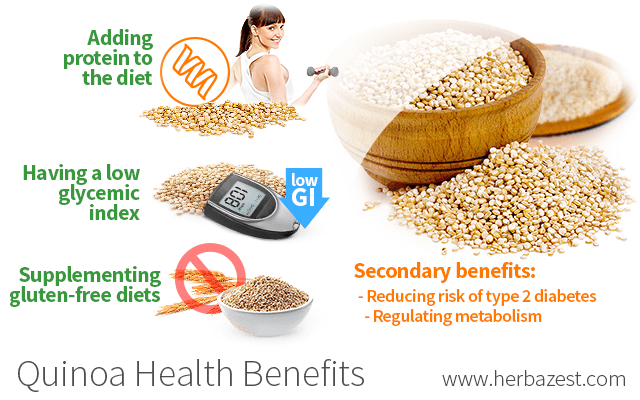As researchers conduct more studies on the health benefits of quinoa, the popularity of this crop is growing all around the world. The majority of quinoa's benefits come from its unique nutritional value, which can be particularly beneficial for at-risk populations or those with unusual dietary needs. Read on to learn more about quinoa's benefits!
Main Benefits of Quinoa
The following are the primary benefits of quinoa:
- Adding protein to the diet. Quinoa contains all nine essential amino acids, which makes it a good source of complete protein. Because of its high quality protein, quinoa represents an important supplemental form of nutrition, especially for children, vegetarians, and vegans. The biological value of protein refers to the protein that is successfully absorbed from food and incorporated into the body. Compared to the biological value of beef (74%), quinoa boasts an astounding 73%.1
- Having a low glycemic index. Glycemic index (GI) refers to the impact of certain carbohydrates on blood sugar levels. A high GI has been linked to rises in blood sugar and insulin levels, while low GI diets have been shown to improve glucose and lipid levels as well as aid in weight control by regulating appetite. The GI of quinoa ranges between 35 - 53, depending on how long it is cooked - compared to white bread, whose GI is around 75. A study published in the Journal of the American Medical Association (2008) reported that a six-month low GI diet including quinoa reduced hemoglobin A1c (a risk indicator for diabetes) and increased in high-density lipoproteins (HDL), better known as good cholesterol.2
- Supplementing gluten-free diets. People with celiac disease and gluten sensitivity can take great advantage of the many benefits of quinoa consumption. A study published in the American Journal of Gastroenterology (2014) concluded that quinoa seeds are a safe, gluten-free alternative to cereal grains.3 During the study, 19 celiac patients consumed 50 grams of quinoa daily for six weeks, and the results demonstrated improvements in the gastrointestinal system.
Secondary Benefits of Quinoa
Lipids are important concentrated sources of energy, and the unsaturated fat content of vegetables has been associated with a reduced risk of type 2 diabetes and inflammation. Quinoa has a total fat content of approximately 14.5%, with 70 - 89% of it being unsaturated.4 Quinoa's anti-diabetic and anti-inflammatory effects may help protect the body against other serious health conditions, such as cardiovascular disease and metabolic disorder.
Quinoa may also be beneficial in helping regulate metabolism. In a study published in the International Journal of Food Sciences and Nutrition (2014), quinoa was shown to significantly reduce serum triglycerides, cholesterol, and low-density lipoproteins (LDL) while increasing glutathione, an important antioxidant.5 This study demonstrated the possible benefits of quinoa in reducing cholesterol and helping to regulate metabolism.
As a result of its great nutritional value, quinoa has many health benefits to offer. Being both an important protein supplement and a safe, gluten-free food, consider is a worthwhile addition to a daily diet.
Sources
- Comprehensive Reviews in Food Science and Food Safety, Innovations in Health Value and Functional Food Development of Quinoa (Chenopodium quinoa Willd.), 2015
- Harvard University, Glycemic index and glycemic load for 100+ foods
- International Journal of Food Sciences and Nutrition, Metabolic parameters of postmenopausal women after quinoa or corn flakes intake—a prospective and double-blind study, 2014
- Journal of Nutrition and Food Sciences, Quinoa (Chenopodium quinoa Willd), from Nutritional Value to Potential Health Benefits: An Integrative Review, 2016
- Plant Foods for Human Nutrition, Effect of Diet Supplemented with Quinoa Seeds on Oxidative Status in Plasma and Selected Tissues of High Fructose-Fed Rats, 2010
Footnotes:
- Journal of Nutrition & Food Sciences. (2016). Quinoa (Chenopodium quinoa Willd), from Nutritional Value to Potential Health Benefits: An Integrative Review. Retrieved September 20, 2021 from https://www.longdom.org/open-access/quinoa-chenopodium-quinoa-willd-from-nutritional-value-to-potential-health-benefits-an-integrative-review-2155-9600-1000497.pdf
- Journal of the American Medical Association. (2008). Effect of a Low-Glycemic Index or a High-Cereal Fiber Diet on Type 2 Diabetes. Retrieved August 18, 2022 fromhttps://pubmed.ncbi.nlm.nih.gov/19088352/
- American Journal of Gastroenterology. (2014). Gastrointestinal Effects of Eating Quinoa (Chenopodium quinoa Willd.) in Celiac Patients. Retrieved August 18, 2022 from https://pubmed.ncbi.nlm.nih.gov/24445568/
- Journal of Agricultural and Food Chemistry. (2016). Assessing the Fatty Acid, Carotenoid, and Tocopherol Compositions of Amaranth and Quinoa Seeds Grown in Ontario and Their Overall Contribution to Nutritional Quality. Retrieved August 18, 2022 from https://www.researchgate.net/publication/290432245_Assessing_the_Fatty_Acid_Carotenoid_and_Tocopherol_Compositions_of_Amaranth_and_Quinoa_Seeds_Grown_in_Ontario_and_Their_Overall_Contribution_to_Nutritional_Qualit
- International Journal of Food Sciences and Nutrition. (2014). Metabolic parameters of postmenopausal women after quinoa or corn flakes intake—a prospective and double-blind study. Retrieved August 18, 2022 from https://pubmed.ncbi.nlm.nih.gov/24344670/




